How to Plant Papaya Seeds: A Detailed Guide for Lush Growth
- February 21, 2024
- 0 comment
Papayas, with their sweet and tropical flavor, are not only a delicious fruit but also an exciting plant to grow in your garden. This guide will walk you through the process of planting papaya seeds, ensuring a healthy growth journey from seed to fruit-bearing tree.
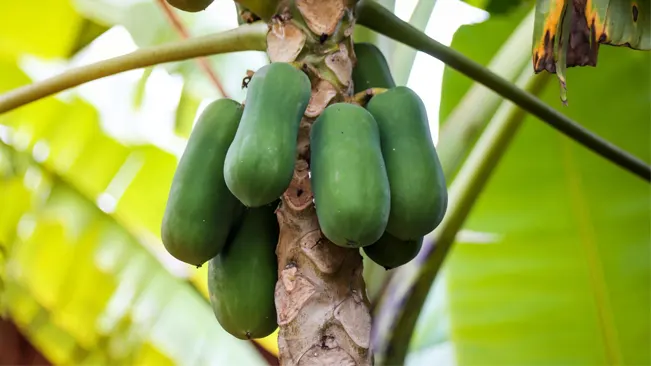
Nutritional Benefits of Papaya
| Benefit | Description |
|---|---|
| Nutritional Value | Papaya is rich in Vitamin C, Vitamin A, and folate. It also contains fiber, potassium, and antioxidants like lycopene. |
| Digestive Health | The fruit contains the enzyme papain, which aids in digestion and can help break down proteins. It can also alleviate constipation and promote regular bowel movement. |
| Immune Support | High in Vitamin C and antioxidants, papaya can boost the immune system and protect against various illnesses. |
| Anti-inflammatory Properties | Papaya has anti-inflammatory properties due to its high content of vitamins and enzymes, helping in reducing inflammation in the body. |
| Skin Health | Rich in vitamins A and C, papaya can contribute to healthier skin. It is often used in skincare products for its rejuvenating properties. |
| Heart Health | The fiber, potassium, and vitamins in papaya can support heart health and reduce the risk of heart disease. |
| Anti-Cancer Properties | The antioxidants in papaya, particularly lycopene, may have cancer-fighting properties and can reduce the risk of certain types of cancers. |
| Diabetes Management | The low sugar and high fiber content in papaya make it suitable for diabetics, helping in regulating blood sugar levels. |
| Eye Health | Papaya is rich in Vitamin A and beta-carotene, which are essential for eye health and can reduce the risk of age-related macular degeneration. |
| Weight Loss | Being low in calories and high in fiber, papaya can aid in weight loss as part of a healthy diet. |
Materials Needed
- Papaya seeds
- Potting soil
- Pots or a garden space
- Watering can or hose
- Fertilizer (optional)
- Gloves (optional)
Extracting and Preparing the Seeds
Selecting the Right Papaya
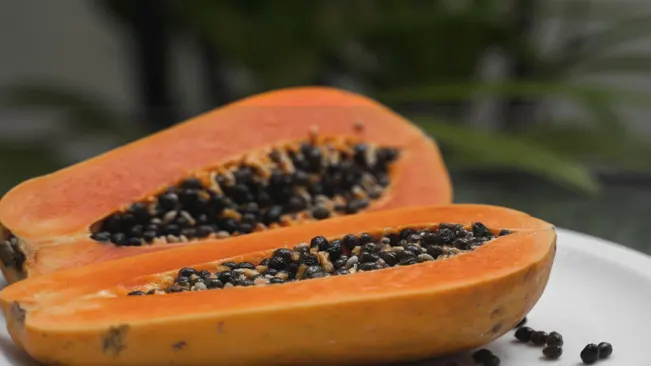
- Start by choosing a ripe papaya. Ripe papayas are usually soft to the touch, and their skin has turned from green to a more yellow or orange hue. The ripeness of the fruit is crucial because it ensures that the seeds inside are mature and ready for planting.
- Preferably, opt for papayas from organic sources or those known for their quality and taste, as the seeds are likely to inherit these characteristics.
Cutting the Papaya

- Wash the outer skin of the papaya to remove any dirt or residue.
- Use a sharp knife to cut the fruit open. You can slice it lengthwise or across the middle, depending on your preference.
- Be gentle while cutting to avoid damaging the seeds inside.
Scooping Out the Seeds

- Once the papaya is open, you’ll notice the seeds are clustered in the center, surrounded by a gelatinous sac.
- Use a spoon to gently scoop out the seeds. Try not to crush them, as this could damage the embryo inside.
- If you find it challenging to remove all the seeds, you can gently squeeze the papaya halves to loosen them.
Rinsing the Seeds
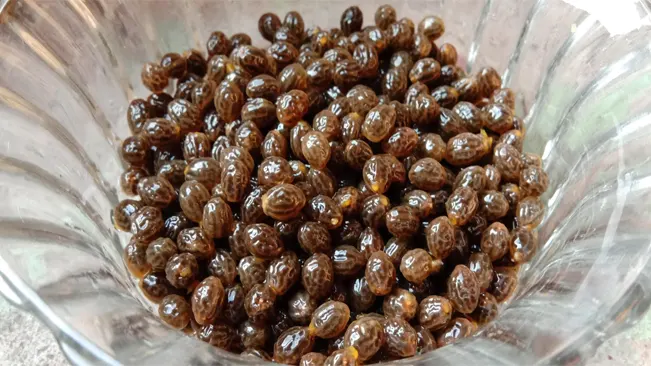
- Place the extracted seeds in a fine mesh strainer.
- Run cold water over the seeds while gently agitating them with your fingers or a spoon to help remove the surrounding sac and any attached fruit pulp. This step is crucial as the sac and pulp can promote fungal growth and inhibit germination if left on the seed.
- Continue rinsing until the seeds are clean and the water runs clear.
Soaking the Seeds (Optional but Recommended)
- For quicker germination, soak the cleaned seeds in warm water for 24 hours.
- Use a container that allows the seeds enough space to expand. The water should be approximately at room temperature; too hot water can damage the seeds.
- This soaking process helps to soften the outer layer of the seeds, making it easier for the sprout to break through.
Drying the Seeds (If not planting immediately)
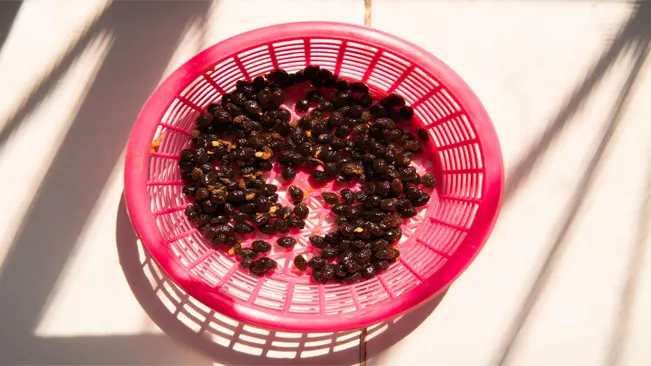
- If you’re not planting the seeds right after soaking, spread them out on a paper towel or cloth to dry.
- Make sure they are completely dry to prevent mold growth.
- Once dry, the seeds can be stored in a cool, dry place until you are ready to plant them.
Planting the Seeds
Preparing the Soil

- Quality of Soil: Papaya trees thrive in rich, well-drained soil. This means the soil should be fertile and have the ability to retain enough moisture without becoming waterlogged. A mix of garden soil, compost, and some sand or perlite is ideal for potting.
- pH Level: Papayas prefer a slightly acidic to neutral pH, typically between 6.0 and 7.0.
Choosing the Right Location
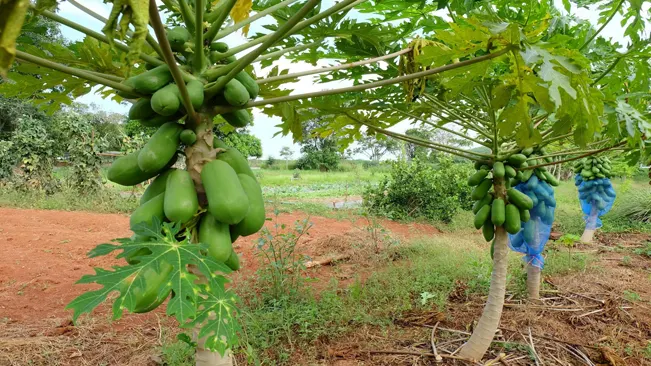
- Sunlight: Papayas need a lot of sunlight, so choose a location that receives full sun for most of the day, whether it’s in a pot or in your garden.
- Drainage: Ensure the spot or pot has good drainage to prevent water from pooling around the roots, which can cause rot.
Planting the Seeds

- Depth and Spacing: Plant the seeds about ¼ inch deep in the soil. This shallow planting helps the seeds receive adequate warmth and light to germinate effectively. If you’re planting multiple seeds in a pot, space them about 2-3 inches apart. In a garden, space them 5-8 feet apart. Papaya trees grow quite large and need room to spread out.
- Pot Size: If planting in pots, start with a small to medium-sized pot and be prepared to transplant as the tree grows. This will ensure the roots have enough room to expand.
Watering the Seeds

- Initial Watering: After planting the seeds, water the soil gently but thoroughly. The goal is to moisten the soil without causing it to become soggy.
- Consistent Moisture: Keep the soil consistently moist during the germination period. This might mean watering lightly every day or every other day, depending on the climate and soil type.
- Avoid Over-watering: Over-watering can be detrimental at this stage, as it can lead to fungal diseases or rot. Ensure your pot has drainage holes or that your garden bed does not retain excess water.
Germination
Factors Influencing Germination
- Time Frame: Papaya seeds typically take about two weeks to germinate, but this can vary based on environmental conditions. In some cases, it might take up to a month for the seeds to sprout.
- Moisture: The soil must be consistently moist during the germination period. However, it’s important to avoid over-watering, which can lead to seed rot. The ideal condition is a well-drained soil that retains enough moisture to hydrate the seeds without becoming waterlogged.
- Temperature: Papaya seeds thrive in warm conditions. A temperature range of 70-90°F (21-32°C) is ideal. If you’re growing the seeds indoors, consider placing them near a window that gets plenty of sunlight or in a greenhouse. For outdoor planting, ensure the environment is warm enough, especially during the night.
- Light: While light isn’t directly required for the germination of papaya seeds, placing the pots in a sunny location encourages healthy growth once the seedlings emerge. Sunlight is crucial for the young plant to develop strong and healthy.
Tips for Successful Germination
- Soil Preparation: Use a high-quality potting mix that provides good drainage. You can also mix in some sand or perlite to improve soil aeration.
- Seed Treatment: Before planting, some gardeners recommend soaking the seeds in lukewarm water for 24 hours. This can help soften the seed’s outer layer and speed up germination.
- Planting Depth: Plant the seeds about ¼ inch deep in the soil. This shallow planting helps the seedlings break through the soil surface more easily.
- Consistent Care: Check the moisture level of the soil daily. The top layer should feel moist but not soggy. Using a spray bottle to mist the soil can prevent over-watering.
- Patience: Germination is a waiting game. Regularly monitor the pots and be patient. It might take longer than two weeks, especially in cooler temperatures.
Care and Maintenance
Selecting and Thinning Seedlings
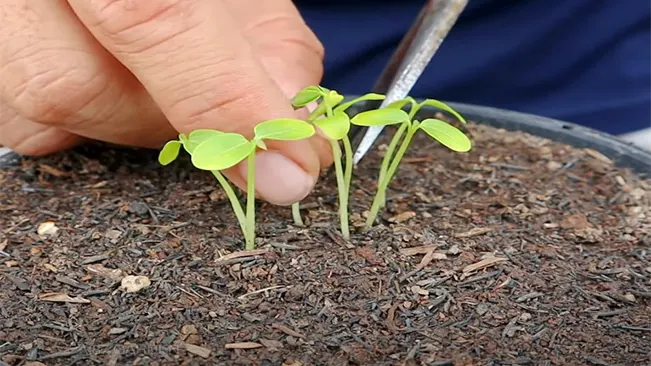
- Observation: After the papaya seeds germinate and seedlings emerge, observe their growth over a few days. You’ll notice variations in their vigor and size.
- Selection: Choose the strongest and healthiest-looking seedling in each pot. This is typically the one that’s tallest, has the greenest leaves, and shows the most robust growth.
- Thinning: Carefully remove the other seedlings. This can be done by snipping them at the soil level with scissors. Avoid pulling them out, as this can disturb the roots of the seedling you wish to keep.
Watering Practices
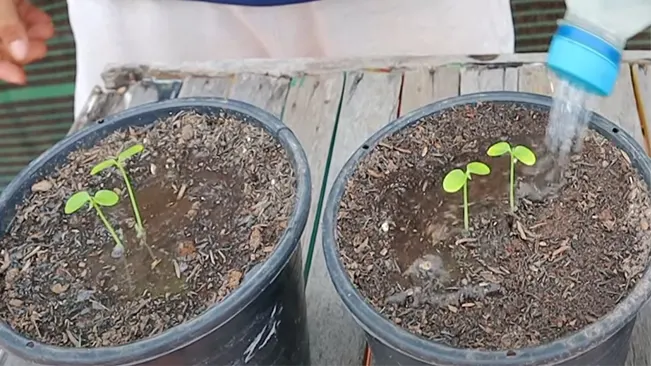
- Consistency: Regular watering is key. Young papaya plants are particularly sensitive to drought.
- Method: Water the plants at the soil level, avoiding wetting the leaves, as this can promote fungal diseases.
- Amount: Ensure the soil is moist but not waterlogged. Over-watering can lead to root rot, a common issue in papaya plants.
- Frequency: Watering frequency depends on your climate and soil type. As a general rule, allow the top inch of soil to dry out before watering again. In hot, dry climates, this might mean watering every other day, while in cooler or more humid environments, less frequent watering might be needed.
Fertilization
- Type of Fertilizer: Use a balanced, all-purpose fertilizer. Look for one with equal parts nitrogen, phosphorus, and potassium (NPK), such as a 10-10-10 formula.
- Application: Apply the fertilizer according to the package instructions. Usually, this is done monthly.
- Method: Spread the fertilizer evenly around the base of the plant, away from the stem. Water the soil after applying to help distribute the nutrients.
- Note: Be cautious not to over-fertilize, as this can harm the plants. Signs of over-fertilization include yellowing or browning of leaf tips and margins.
Additional Tips
- Monitoring for Pests and Diseases: Regularly check your papaya plants for signs of pests or diseases. Treat any infestations promptly to prevent spread.
- Mulching: Applying a layer of organic mulch around the base of the plants can help retain soil moisture and suppress weeds.
- Pruning: While papaya trees don’t require extensive pruning, removing any dead or diseased leaves and branches helps promote healthy growth and air circulation.
Transplanting (if necessary)
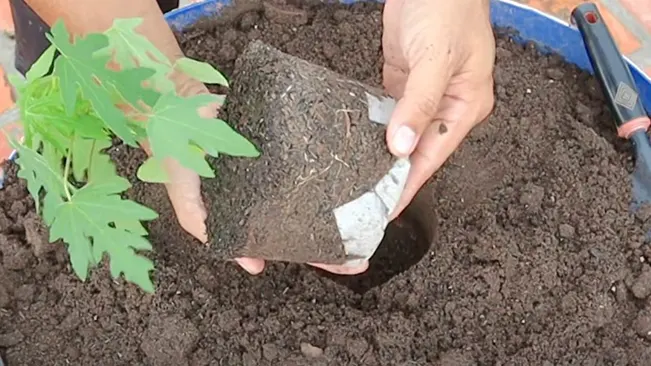
- If you started your seeds in pots, transplant them to the garden when they are about a foot tall.
- Be careful not to damage the roots during transplantation.
Ongoing Care
Supporting the Tree
As papaya trees grow, they can become quite top-heavy, especially when they start bearing fruit. This characteristic makes them susceptible to falling over in strong winds or under the weight of their own fruit.
- Staking: To prevent this, it’s advisable to stake the tree. A wooden or metal stake driven into the ground next to the tree provides support. Tie the tree to the stake loosely with soft material, like cloth strips, to avoid damaging the trunk.
- Pruning: Pruning is not typically required for papaya trees, but removing any dead or damaged limbs can help maintain the tree’s health and stability.
Pest and Disease Management
Papaya trees are prone to several pests and diseases, which can affect both the tree and the fruit.
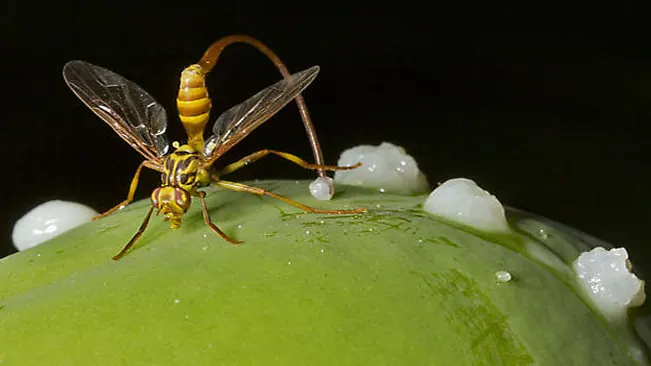
- Common Pests: These include aphids, spider mites, and fruit flies. Natural remedies like neem oil or insecticidal soaps can be effective. It’s also beneficial to encourage natural predators like ladybugs in your garden.
- Diseases: Papaya trees can suffer from fungal diseases such as anthracnose and root rot. To prevent these, ensure good air circulation around the tree and avoid over-watering. Fungicides can be used for severe infections.
- Regular Inspection: Regularly inspecting your papaya tree for signs of pests or diseases is crucial. Early detection and treatment can prevent more significant problems.
Fruit Production

- Time to Bear Fruit: Papaya trees are fast growers and usually start producing fruit within 6-12 months of planting, depending on the variety and growing conditions.
- Harvesting: Papayas are harvested when they show a change in color from green to yellow. They don’t all ripen at once, so you can enjoy a steady supply over several weeks.
- Fruit Care: Handle the fruit carefully as papayas bruise easily. Once picked, they can ripen off the tree at room temperature.
- Pollination: Some papaya varieties require a male tree nearby for the female tree to produce fruit. If your tree isn’t bearing fruit, lack of pollination could be the issue.
Conclusion
Planting papaya seeds can be a rewarding experience. With patience and proper care, you’ll be able to enjoy your own homegrown papayas. Remember, papaya trees love the sun and need plenty of space to flourish
FAQs (Frequently Asked Questions)
- Can I plant seeds from a store-bought papaya?
Yes, you can plant seeds from a store-bought papaya. Ensure the papaya is ripe and the seeds are fresh for the best germination results. - Do I need to dry the papaya seeds before planting?
It’s not necessary to dry the seeds. You can rinse them to remove the pulp and plant them directly, although some gardeners prefer to dry them for a day or two. - How deep should I plant papaya seeds?
Plant papaya seeds about ¼ inch deep in the soil. - How long does it take for papaya seeds to germinate?
Papaya seeds typically germinate within 2 to 3 weeks, but it can sometimes take longer depending on conditions. - What is the best soil for planting papaya seeds?
Use a well-draining soil rich in organic matter. Papayas prefer a pH between 5.5 and 7.0. - How much sunlight do papaya plants need?
Papaya plants need full sun, so choose a location that receives at least 6 hours of direct sunlight daily. - When should I transplant papaya seedlings?
Transplant papaya seedlings when they are about 6-12 inches tall, ensuring minimal disturbance to the roots. - How much water do papaya seedlings need?
Water the seedlings regularly to keep the soil moist but not waterlogged. Over-watering can lead to root rot. - Do papaya trees need fertilizer?
Yes, papaya trees benefit from regular fertilization. Use a balanced, slow-release fertilizer every 4-6 weeks during the growing season. - How long until a papaya tree bears fruit?
Papaya trees typically start bearing fruit within 6-12 months after planting, depending on the variety and growing conditions.

Kristine Moore
Forestry AuthorI'm Kristine Moore, a seasoned garden landscaping professional with over 30 years of experience. My extensive career has been dedicated to transforming outdoor spaces into stunning, sustainable landscapes. With a deep understanding of horticulture, design principles, and environmental stewardship, I have become a respected figure in the field, known for creating harmonious, visually appealing, and eco-friendly gardens. My commitment to excellence and continuous learning in landscaping trends and techniques has solidified my reputation as an expert in garden design and implementation.

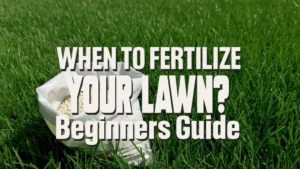

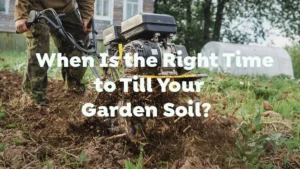



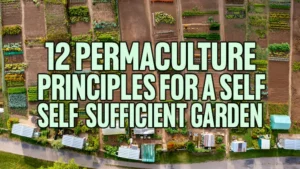




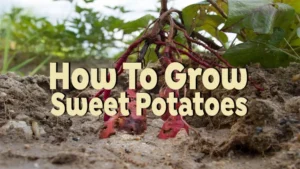
Leave your comment